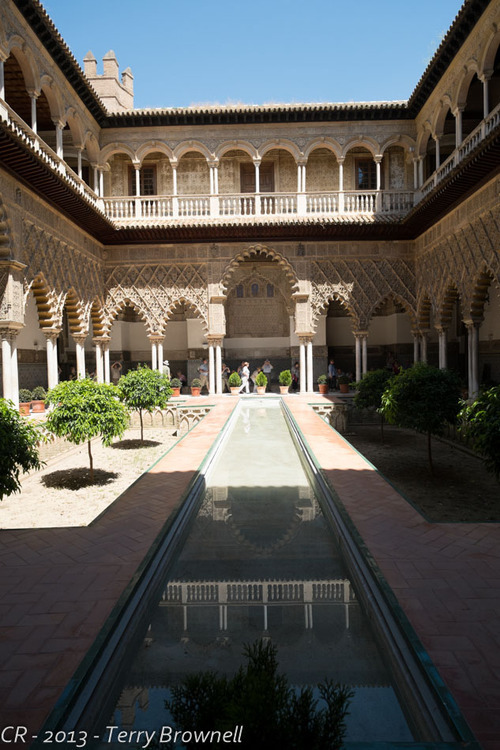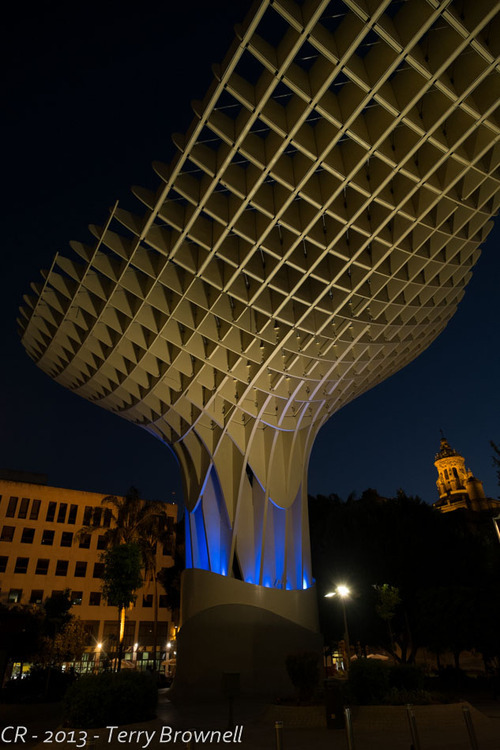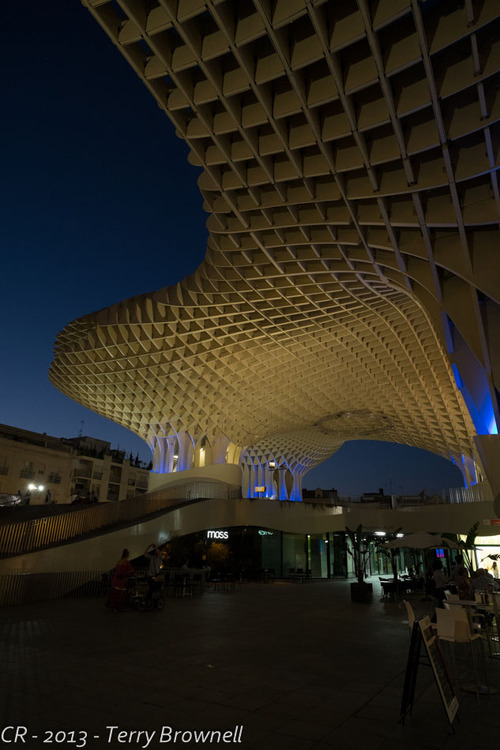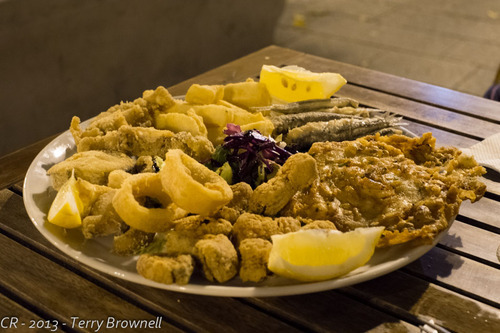April 17th: The rest of the day
A bit past the noon hour we took off in the direction of the the old city, hugging the shady side of the street. It was well into the high 80s. Due to some random combination of street choices, we found ourselves behind the cathedral and then in front of the Alcazar Real – the original seat of the Catholic Kings in Spain. Figuring it would be better to wander around in a shady old rock building, we paid and went in.
It didn’t take more that a hundred steps to know we’d found ourselves in an amazing place. Built on the foundation of a 10th century Moorish palace, the Alcazar has been sporadically constructed over the last 7 centuries, begun by Pedro I “The Cruel” in 1364 and modified ever since. Its various pieces and parts represent every major building style in Europe.
Pedro, having recently re-Christianized Sevilla employed Muslim and Christian craftsman to build a palace worthy of a king. The resulting “Mudejar” style is a striking combination of the best of both with cavernous cathedral style rooms off of delicate patios, open to the sky with water flowing and walls composed of graceful arches, heavily carved and adorned. You simply walk from room to room agape at the beauty and tranquility. The Alcazar is a place where you could spend a day doing nothing other than photographing ceilings and tile work, both of which are breathtaking and incredibly diverse. The ceiling in the Salon de Embajadores is the most spectacular, a giant half doom of blue and gold, gracing the room where Christopher Columbus recounted the tales of his first voyage to the New World to an anxious Queen Isabella. Just standing in that space alone is enough to give you pause.
We ended up with so many beautiful photos, too many to put in this blog so I have created a gallery here for your viewing pleasure.
Just click on the link -
The Alcazar Real
But before you go there, here is one to wet your appetite, the Patio de las Doncellas

It took the better part of 4 hours to cover the place well, between the dozens of rooms, the paintings, the extremely extensive gardens and a decent exhibition of tile craft, something for which this region is famous. Having done the Alcazar justice, we went off in search of late lunch.
The area around the cathedral is full of tiny tapas places and we chose Cervezeria Giralda based on a recommendation from one of our books. It was a good choice – a big bottle of ice cold water, mushrooms stuffed with Andalusian sausage, rabbit al mojo de ajo and what turned out to be the best tapa I’ve ever eating, slices of duck breast served on mushroom with some kind of fruity wine sauce. A good waiter, some lessons in Spanish and English and a double scoop each of ice cream to send us on our way in the late afternoon sun. As we walking back to our apartment for a break, we noticed that the practice of Siesta is still in use, even the major department stores were shuttered.
We took a couple of hours of rest while the city cooled off before going back out in search of dinner. We’ve always felt a bit like bumpkins on our past trips here, looking for dinner in empty restaurants preparing for the evening trade which often doesn’t begin until 10. This evening though, we headed north into the Macarena district and strolled down the Alameda de Hercules, named for two Roman statues that stand on pillars at the south end of the promenade. This area was non-tourist with regular families hanging out in the shade, children playing and dogs running wild. Not yet gentrified by the tourist trade, it was funky and interesting after the crush of the old city. We continued north and then southeast along a street that hugged the path of the old city walls, a portion of which still stands near the Basillica Macarena, a not-old cathedral with a beautiful interior. We popped in while evening Mass was underway.
We got moderately lost on the way back, ending up on a beautiful windy lane instead of the major road we were looking for. It was probably a propitious accident because it was cool, dark and quiet.
Eventually we found the street we were looking for and turned in the direction of the restaurant we were planning to try. Passing under the most very modern, Metropol Parasol. Designed by architect Jurgen-Mayer Hermann and completed in April 2011, the wooden structure is designed to look like giant mushrooms and is popularly known as Las Setas de Encarnacion or Mushrooms of the Incarnation after the plaza in which is stands. The thing is huge, and very hard to photograph between its size, shape and position among the surrounding buildings.


The plan for dinner was to sample fried fish, the surprising choice as the most famous local dish. We grabbed a table at the restaurant we’d scoped out earlier, ordering a beer and a glass of wine and listening intently to the description of the offerings in Spanish of which we captured about 10%. Our decision was to just let what comes, come and it turned out to be a good one – a giant plate of fried squid, octopus, white fish, clams, sardines served with a couple of potato crepes and a pile of salad. It was spectacular in appearance and taste and My Lovely Wife even got a hug and a kiss on both cheeks when the waitress realized she was getting a tip. Such is the power of being a kindly tourist.

It didn’t take more that a hundred steps to know we’d found ourselves in an amazing place. Built on the foundation of a 10th century Moorish palace, the Alcazar has been sporadically constructed over the last 7 centuries, begun by Pedro I “The Cruel” in 1364 and modified ever since. Its various pieces and parts represent every major building style in Europe.
Pedro, having recently re-Christianized Sevilla employed Muslim and Christian craftsman to build a palace worthy of a king. The resulting “Mudejar” style is a striking combination of the best of both with cavernous cathedral style rooms off of delicate patios, open to the sky with water flowing and walls composed of graceful arches, heavily carved and adorned. You simply walk from room to room agape at the beauty and tranquility. The Alcazar is a place where you could spend a day doing nothing other than photographing ceilings and tile work, both of which are breathtaking and incredibly diverse. The ceiling in the Salon de Embajadores is the most spectacular, a giant half doom of blue and gold, gracing the room where Christopher Columbus recounted the tales of his first voyage to the New World to an anxious Queen Isabella. Just standing in that space alone is enough to give you pause.
We ended up with so many beautiful photos, too many to put in this blog so I have created a gallery here for your viewing pleasure.
Just click on the link -
The Alcazar Real
But before you go there, here is one to wet your appetite, the Patio de las Doncellas

It took the better part of 4 hours to cover the place well, between the dozens of rooms, the paintings, the extremely extensive gardens and a decent exhibition of tile craft, something for which this region is famous. Having done the Alcazar justice, we went off in search of late lunch.
The area around the cathedral is full of tiny tapas places and we chose Cervezeria Giralda based on a recommendation from one of our books. It was a good choice – a big bottle of ice cold water, mushrooms stuffed with Andalusian sausage, rabbit al mojo de ajo and what turned out to be the best tapa I’ve ever eating, slices of duck breast served on mushroom with some kind of fruity wine sauce. A good waiter, some lessons in Spanish and English and a double scoop each of ice cream to send us on our way in the late afternoon sun. As we walking back to our apartment for a break, we noticed that the practice of Siesta is still in use, even the major department stores were shuttered.
We took a couple of hours of rest while the city cooled off before going back out in search of dinner. We’ve always felt a bit like bumpkins on our past trips here, looking for dinner in empty restaurants preparing for the evening trade which often doesn’t begin until 10. This evening though, we headed north into the Macarena district and strolled down the Alameda de Hercules, named for two Roman statues that stand on pillars at the south end of the promenade. This area was non-tourist with regular families hanging out in the shade, children playing and dogs running wild. Not yet gentrified by the tourist trade, it was funky and interesting after the crush of the old city. We continued north and then southeast along a street that hugged the path of the old city walls, a portion of which still stands near the Basillica Macarena, a not-old cathedral with a beautiful interior. We popped in while evening Mass was underway.
We got moderately lost on the way back, ending up on a beautiful windy lane instead of the major road we were looking for. It was probably a propitious accident because it was cool, dark and quiet.
Eventually we found the street we were looking for and turned in the direction of the restaurant we were planning to try. Passing under the most very modern, Metropol Parasol. Designed by architect Jurgen-Mayer Hermann and completed in April 2011, the wooden structure is designed to look like giant mushrooms and is popularly known as Las Setas de Encarnacion or Mushrooms of the Incarnation after the plaza in which is stands. The thing is huge, and very hard to photograph between its size, shape and position among the surrounding buildings.


The plan for dinner was to sample fried fish, the surprising choice as the most famous local dish. We grabbed a table at the restaurant we’d scoped out earlier, ordering a beer and a glass of wine and listening intently to the description of the offerings in Spanish of which we captured about 10%. Our decision was to just let what comes, come and it turned out to be a good one – a giant plate of fried squid, octopus, white fish, clams, sardines served with a couple of potato crepes and a pile of salad. It was spectacular in appearance and taste and My Lovely Wife even got a hug and a kiss on both cheeks when the waitress realized she was getting a tip. Such is the power of being a kindly tourist.




Comments